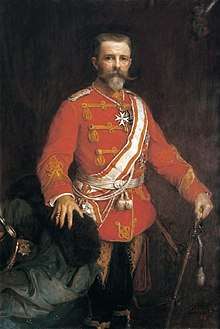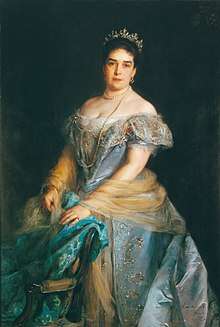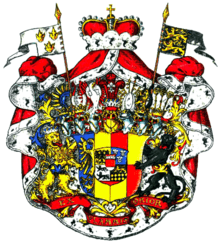Victor II, Duke of Ratibor
Victor II, Duke of Ratibor, Prince of Corvey, Prince of Hohenlohe-Schillingsfürst (German: Viktor Amadeus 2.Herzog von Ratibor, 2.Fürst von Corvey, Prinz zu Hohenlohe-Schillingsfürst; 6 September 1847 – 9 August 1923) was a member of House of Hohenlohe-Schillingsfürst and Duke of the Silesian duchy of Ratibor (Polish: Racibórz).
| Victor II | |||||
|---|---|---|---|---|---|
| Duke of Ratibor, Prince of Corvey, Prince of Hohenlohe-Schillingsfürst | |||||
 Victor II painting by Philip de László, 1898 | |||||
| Born | 6 September 1847 Schloss Rauden, Kingdom of Prussia | ||||
| Died | 9 August 1923 (aged 75) Corvey Abbey, Weimar Republic | ||||
| Spouse | Countess Maria Breunner-Enkevoirth | ||||
| Issue |
| ||||
| |||||
| House | Hohenlohe-Schillingsfürst | ||||
| Father | Victor I, Duke of Ratibor | ||||
| Mother | Princess Amélie of Fürstenberg | ||||
Early life and family
Victor was born at Schloss Rauden, Kingdom of Prussia, eldest son of Victor I, Duke of Ratibor (1818–1893), (son of Franz Joseph, Prince of Hohenlohe-Schillingsfürst and Princess Constanze of Hohenlohe-Langenburg) and his wife, Princess Amélie of Fürstenberg (1821–1899), (daughter of Karl Egon II, Prince of Fürstenberg and Princess Amalie of Baden).
Ratibor studied Law in Bonn and Göttingen and was a member of the Corps Borussia (1867) and Saxonia (1890). In Saxonia was also were his four brothers, Max, Karl Egon, Franz (Colonel à la suite) and Egon (Lord Chamberlain).
Military career
After making his Doctorate in Law he entered the Potsdamer Life Guards Hussar Regiment in which he fought during the Franco-Prussian War.
Political career
Between 1873 and 1876 he worked at the German Embassy in Vienna. In 1893 he took over the dominions Kieferstädtel and Zembowitz in Upper Silesia.
From 1897 to 1921 he was Chairman of the Silesia Province respectively of the Upper Silesian provincial parliament. As a member of the Free Conservative Party, he ran in 1885 and 1888 for the Prussian House of Representatives. Since 1893, he was a member of the Prussian House of Lords. From 1896 to 1904 he was chairman of the New Coalition Party.
In 1913 he became honorary citizen of Breslau.
Marriage

Victor married 19 June 1877 at Vienna to Countess Maria Breunner-Enkevoirth (1856–1929), daughter of Count August Breunner-Enkevoirth, and his wife, Countess Agatha Széchényi de Sárvár-Felsövidék.
They had four children:
- Victor III, Duke of Ratibor (2 February 1879 – 11 November 1945), married in 1910 to Princess Elisabeth of Oettingen-Oettingen and Oettingen-Spielberg, had issue.
- Prince Hans of Hohenlohe-Schillingsfürst (8 March 1882 – 5 January 1948), married in 1918 to Princess Marie of Windisch-Graetz, no issue.
- Princess Agatha of Hohenlohe-Schillingsfürst (24 July 1888 – 12 December 1960), married in 1910 to Prince Friedrich Wilhelm of Prussia, had issue.
- Princess Margaret of Hohenlohe-Schillingsfürst (3 Mar 1894–1973)
Titles and styles

- 6 September 1847 – 30 January 1893: His Serene Highness Prince Victor of Ratibor and Corvey, Prince of Hohenlohe-Schillingsfürst
- 30 January 1893 – 9 August 1923: His Serene Highness The Duke of Ratibor, Prince of Corvey
Ancestry
| Ancestors of Victor II, Duke of Ratibor | |||||||||||||||||||||||||||||||||||||||||||||||||||||||||||||||||||||||||||||||||||||||||||||||||||||||||||||||||||||||||||||||||||||||||||||||||||||||||||||||||||||||||||||||||||||||||||||||||||||||||||||||||||||||||||||||||||||||||||||||||||||||||||||||||||||||||||||||||||||||||
|---|---|---|---|---|---|---|---|---|---|---|---|---|---|---|---|---|---|---|---|---|---|---|---|---|---|---|---|---|---|---|---|---|---|---|---|---|---|---|---|---|---|---|---|---|---|---|---|---|---|---|---|---|---|---|---|---|---|---|---|---|---|---|---|---|---|---|---|---|---|---|---|---|---|---|---|---|---|---|---|---|---|---|---|---|---|---|---|---|---|---|---|---|---|---|---|---|---|---|---|---|---|---|---|---|---|---|---|---|---|---|---|---|---|---|---|---|---|---|---|---|---|---|---|---|---|---|---|---|---|---|---|---|---|---|---|---|---|---|---|---|---|---|---|---|---|---|---|---|---|---|---|---|---|---|---|---|---|---|---|---|---|---|---|---|---|---|---|---|---|---|---|---|---|---|---|---|---|---|---|---|---|---|---|---|---|---|---|---|---|---|---|---|---|---|---|---|---|---|---|---|---|---|---|---|---|---|---|---|---|---|---|---|---|---|---|---|---|---|---|---|---|---|---|---|---|---|---|---|---|---|---|---|---|---|---|---|---|---|---|---|---|---|---|---|---|---|---|---|---|---|---|---|---|---|---|---|---|---|---|---|---|---|---|---|---|---|---|---|---|---|---|---|---|---|---|---|---|---|---|---|---|
| |||||||||||||||||||||||||||||||||||||||||||||||||||||||||||||||||||||||||||||||||||||||||||||||||||||||||||||||||||||||||||||||||||||||||||||||||||||||||||||||||||||||||||||||||||||||||||||||||||||||||||||||||||||||||||||||||||||||||||||||||||||||||||||||||||||||||||||||||||||||||
Notes and sources
- thePeerage.com - Viktor Amadeus zu Hohenlohe-Schillingsfürst, 2nd Fürst von Corvey
- Genealogisches Handbuch des Adels, Fürstliche Häuser, Reference: 1956
Victor II, Duke of Ratibor Cadet branch of the House of Hohenlohe Born: 6 September 1847 Died: 9 August 1923 | ||
| German nobility | ||
|---|---|---|
| Preceded by Victor I |
Duke of Ratibor 30 January 1893 – 11 August 1919 |
Succeeded by German nobility titles abolished |
| Prince of Corvey 30 January 1893 – 11 August 1919 | ||
| Titles in pretence | ||
| Loss of title | — TITULAR — Duke of Ratibor 11 August 1919 – 9 August 1923 Reason for succession failure: German nobility titles abolished |
Succeeded by Victor III |
| — TITULAR — Prince of Corvey 11 August 1919 – 9 August 1923 Reason for succession failure: German nobility titles abolished | ||